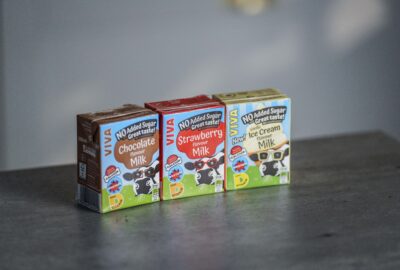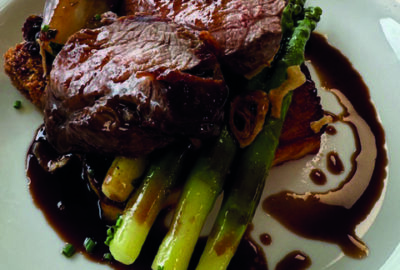Be Waste-Wise
For many kitchens, the first port in the rising cost storm is examining wastage. How much is being thrown away and how can this be minimised? It’s not just about costs but it’s about cooking sustainably as well.
“I think trying to think outside the box without overworking the food is important and to use the whole ingredient to its max with minimum wastage is key. There are lots of ways to maximise expensive proteins without taking away from the ingredient. Keeping it local where possible can help to cut down on wastage massively as well more frequent orders. Looking into other cooking techniques such as preserving can also add flavours and shelf life to many ingredients,” recommends Jean Delport, Executive Chef of Restaurant Interlude at Leonardslee Lakes & Gardens and is the second-ever South African to be awarded a Michelin star.
Nathan Eades, Executive Chef at The Montagu Arms, agrees: “When it comes to waste, any little action will build up over time to make a big difference. It’s imperative we make sure our due diligence is done correctly, whether that is making sure cooks are utilising every ingredient and every part of it or ensuring we don’t over order – it all helps. Chefs also have to get creative. There is always something that can be done with offcuts or leftovers. Build your menu out of ingredients and produce that you know you can use in multiple ways, and that you can use every inch of.”
Award-winning chef and food writer Olia Hercules also preaches a no-waste mantra, which was distilled into her as a child growing up in Ukraine. “It may be a cliché but the main thing is to cut back on your waste. We all need to start thinking extremely creatively. You don’t need to throw away the beetroot and radish tops. Try to find ways to use every ingredient up. We all need to look further and ensure minimal waste,” she says.
Seek Alternative Cuts of Meat
Alternative cuts of meat and the often-sidestepped parts of the animal are becoming increasingly popular. Recognising that we can no longer waste such valuable resources, the industry is putting offal back on the menu and creating some fantastic dishes as a result
“People also need to embrace different cuts and offal and chefs need to utilise them more. In my latest book, I have a broth that my mum used to make which is made out of gizzards. Most people will throw these away if they come in your chicken but I freeze them until I have enough. Then I take them out and make a broth with noodles or rice. Fry the chicken livers as a chefs treat (they will make the broth taste bitter), but the hearts and gizzards have real value for stocks,” says Olia.
Jean, who is also a big advocate of offal, commented: “I find that offal is very underused in the UK, so much to the extent that it has become difficult to source quality offal at a reasonable price. I love offal and really want to champion it more. I think the willingness to eat offal is definitely around, we just need to get it back on the menus!”
Part of the challenge is educating diners about offal “I think we all need educating a little more on offal and it’s certainly something we should consider using more to minimise wastage. Looking at Europe and how our counterparts treat offal and use offal, it is way more integrated into their cuisines,” notes Nathan.
Jamie Tully, Executive Chef at Teulu Restaurant, agrees, saying “Offal is frowned upon but you can do so much with it. Liver, kidney, tongue, it’s cheap, sustainable and not many people use them so it can give you a unique angle if you do it well. We often blend offal with some prime cuts such as rolled saddle of lamb with a kidney stuffing.”
Championing offal in hospitality and at consumer level is Ben Roberts, of M.E. Evans and the Welsh Craft Butchery Team, he recommends working with your butcher to understand more about the various cuts and how it can be cooked. “I always recommend offal as it’s a great product” he says, “it can often be considered a waste product, so consumers and chefs need to be educated on its versatility. Speaking to your butcher about preparation and then cooking it in the right way can create a multitude of meals. Chris Roberts, a chef from Caernarfon, is incredible on the BBQ and I saw him cook an ox heart. He trimmed the meat away and treated it like quality steak, very delicate but richer in flavour. You can get 1kg of ox heart for about £4-5, whereas 1kg of fillet steak would be £50-60. Offal is also typically very lean but high in key nutrients that we need and are often lacking so it can be a good way of fortifying dishes, especially in the winter months.”
Explore New Sources of Meat
Outside of the insides, game is another often forgotten area where the UK has real strength and presents fantastic opportunities for chefs to be creative. “Game is a big resource chefs should be considering using more of. When possible, I like to get outdoors and get involved in the countryside and gamekeepers are often telling me that they don’t have an outlet for their carcasses post shoot. Shooters will pay for the rearing of the birds but often don’t want to take them home so many end up as dog food which is a great waste. It’s a fantastic product that is high in protein and low in cholesterol,” comments Ben.
“During the main season – October to February – there is a whole host of game available to use including partridge, duck, pheasant and venison. However, there are challenges as registered game dealers can seem expensive but if you have the skills, space and resources to hang and dress your game, it is well worth speaking to, and building a relationship with local gamekeepers.”
Jean Delport believes more needs to be done to give alternative meat game time on menus. “I think game meat as a whole is massively overlooked within the UK,” he says. “There are masses of wild birds and venison on our doorstep that we can obtain and that can be used in the same way as many other popular proteins, but for a fraction of the cost. Meat cuts are very personal and specific to menus and chefs, but always keep an open mind and be willing to see what else can work.”
Nathan Eades agrees that chefs should be using more game on their menus, looking to local game keepers for advice and build a relationship to get the most out of the supply opportunities. “Pheasant has always featured in all of my menus as it’s so versatile – from schnitzels to dumplings – and is a great addition to any menu.”
Success in 2023 will centre around keeping in touch with your suppliers, making the most out of seasonal produce, assessing what you’re currently doing, continuously looking for improvements and maximising every ounce of equipment, time and ingredients that you have at your disposal. Looking to alternative cuts of meat, offal and game will, for many operators, be an opportunity too good to miss.


